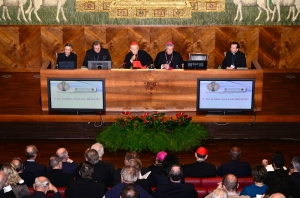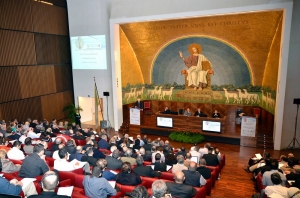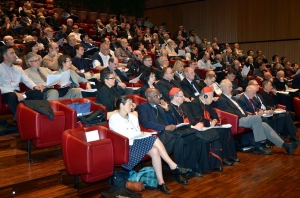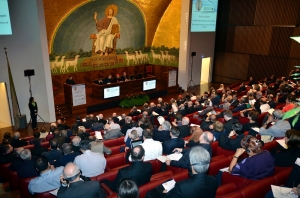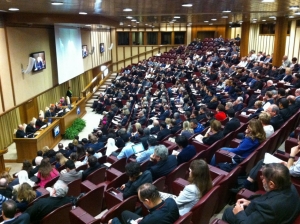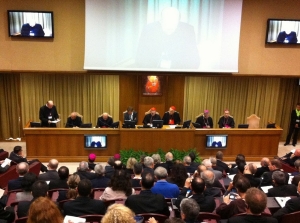The Ratzinger Symposium on Historical and Christological Research of the Gospels
Andrew Dalton, L.C.
Richard A. Burridge, Winner of the 2013 Ratzinger Prize
From October 24 to 26, 2013, a symposium of the Joseph Ratzinger-Benedict XVI Vatican Foundation, entitled “The Gospels: History and Christology,” was held at the Pontifical Lateran University in Rome. On the symposium’s last day, Pope Francis awarded the Ratzinger Prize to joint recipients, one of which was the Anglican Biblical scholar and dean of King’s College in London, Reverend Canon Professor Richard A. Burridge.
The honor of being the first non-Catholic to receive the award went to Burridge for demonstrating the Gospels’ inseparable connection to Jesus of Nazareth. Burridge published his doctoral thesis on the genre of the gospels in 1992, as What are the Gospels? A Comparison with Graeco-Roman Biography. Twenty years after the original publication of his doctorate on this topic, the Anglican professor affirmed at the symposium in Rome that the purpose of his paper was “to consider the historical and Christological themes for this conference, particularly with regard to the biographical genre of the gospels, and the consequences of this for how we read and study them today.”
Structure and Preliminary Considerations
He parsed his exposition into three parts: first, the implications of the Dogmatic Constitution on Divine Revelation, Dei Verbum (DV), for the gospels and ancient biography; second, an explanation of the author’s own research on the gospels as biography; and third, the consequences of this genre for the scholarly work of other Biblical theologians, especially those related to Pope Benedict’s Jesus of Nazareth.
In the first section of his paper, Burridge takes up the question about the relationship between Christology and history, using as his starting point DV 2, which links revelation through Christ and the history of salvation. What is unique to Christianity among all world religions, Burridge argues, is that it is “rooted in an event of history about a person.” But what kind of literature packages this revelation from God? Burridge sets the stage for his thesis with a discussion about the literary genre that best suits history. Diverging translations of DV 19 (“historical character” or “historical documents”) testify to the difficulty of the question. Whatever the best understanding is of Luke 1.4 –“that we might know the veritatem (truth, certainty, reliability) concerning the things of which we have been informed”– Burridge is intent on making the bold and risky claim: “something has really happened in human affairs through a particular person, Jesus of Nazareth.”
Such confidence does not imply that Burridge’s analysis is not nuanced. “Truth” and “facticity” are not necessarily interchangeable terms, he argues. And while “lies” or “deception” are incompatible with “truth,” the same is not necessarily true of “fiction.”
Burridge discerns a like-minded approach in the Foreword of Jesus of Nazareth, in which Pope Benedict gives great weight to both Christology and history and frowns upon the radical separation of the so-called “historical Jesus” and the “Christ of faith.” In fact, it seems the nucleus of Ratzinger’s approach is to acknowledge at once the indispensability of the historical-critical method and the need to transcend its limits by employing a “Christological hermeneutic which sees Jesus Christ as the key to the whole.”
Arguing the Thesis: the Gospels are Ancient Biographies
Having paved the way with these preliminary considerations, Burridge then puts forth his own thesis. In short, his idea is that to have a proper understanding of what DV 12 meant in referring to genera litteraria, one must see clearly both ancient and modern genre theory. Might it be that what is considered “biography” today might have been written differently in ancient times yet with the same generic characteristics? Burridge aims to show that ancient “Lives”—bioi or vitae—have all the generic features of biography; if so, than modern and ancient biography are essentially one.
Burridge’s proposal has not been commonplace among Biblical scholars of the last century. Many form-critics would side with Bultmann, who asserted that the gospels were non-biographical; in fact, they were not classifiable into any other known genre. Burridge scorns this thesis as “literary nonsense,” since if the gospels were absolutely sui generis, then they would be unintelligible. As of 2002-3, Burridge argues, his opinion has become the “mainstream scholarly position,” a remarkable claim, given that a decade earlier, when the book version of Burridge’s doctorate was published, his was a radical position.
So, according to Burridge, what are the gospels? What generic features are constitutive to them? This “genre theory” was precisely what was lacking in Bultmann’s critique, who assumed that, since the gospels look nothing like modern biographies, they could not merit the same classification. Burridge underlines the injustice of such anachronistic expectations, since only in the late 1800s, with thinkers such as Freud, Marx, Weber and Durkheim, do we see the emergence of a modern understanding of biography. To discern if the gospels are biography, one must compare them instead with ancient biography.
Such a comparison would imply a monumental undertaking—the juxtaposition the gospels and the bioi or vitae written two centuries before or after the gospels. Burridge analyzed five pre-gospel works: Isocrates’ Evagoras (c. 370 BC), Xenophon’s Agesilaus (c. 360 BC), Euripides’ Satyrus (probably III c. BC), Nepos’ Atticus (c. 34-27 BC) and Philo’s Moses (early I c. AD). Likewise, five post-gospel works were examined: Tacitus’ Agricola (98 AD), Plutarch’s Cato Minor (c. 100 AD), Suetonius’ Lives of the Caesars (early II c.), Lucian’s Demonax (later II c.), and Philostratus’ Apollonius of Tyana (early III c.).
In order to identify the generic features that would define “biography” and apply to sundry works over a long period, Burridge needed a genre theory. This he found in the work of Ludwig Wittgenstein, whose theories regarding literary genre were derived from examining human families and the concept of “family resemblance”: siblings need not be twins; their resemblance is sufficient to categorize them as a “family.” Likewise, ancient and modern biography “resemble” each other, Burridge shows, in two major ways: first, externally, in terms of formal structure (continuous prose narrative, length corresponding to a single scroll, chronology of the person from his public debut until death, intention to portray the subject’s character indirectly through words and deeds, range of literary units—namely anecdotes, stories, sayings) and second, internally, in terms of content (ancestry of subject, birth, public debut and public life—not so much private life, as in modern biography—dramatic settings that change and follow the person, serious atmosphere, a detailed account of the subject’s last hours and death, occupying between a quarter to a third of the entire work). Evidently, Burridge succeeded in putting forth a convincing argument, for it is now the “mainstream international scholarly consensus” that the gospels are in the genre of ancient biography.
What consequences can be drawn from this biographical approach to the gospels, and how do they relate to Ratzinger’s Jesus of Nazareth? The author sees a close connection indeed with the intellectual project of Pope Benedict, who in three volumes, attempts his own portrait of the historical person, Jesus Christ. Burridge leans on the analogy of the four living creatures present in the apocalyptic literature of the Bible, which traditional iconography has assigned to the four evangelists but which Irenaeus calls four images of the “dispositions of the Son of God.” If the image is thought to refer not so much to the gospel writer as to Jesus, than the analogy serves to accent unity in diversity: these four unique accounts present their own portrayal in their own way, yet they are four portraits of one person. This thesis is presented in a more recent work by the same author, entitled Four Gospels, One Jesus?
My Personal Assessment
Before attending the Ratzinger Symposium, I had heard that the gospels made up a genre all their own, and I was strongly influenced by this idea. So when I heard Prof. Burridge argue that if what the evangelists wrote were something wholly special, altogether new, then one could not expect them to be understood by the reader, I recoiled spontaneously. His assertion seemed an exaggeration, a non sequitur. Certainly new genres, inside and outside of the world of literature, are being created all the time. A mundane but illustrative example came immediately to mind. The music video as an art form (or genre) did not always exist, but when it was invented, it was intelligible from the start, despite its novelty. New genres usually inherit or overlap traits from previously existing genres (such as silent film or recorded music) which are readily understood.
Nevertheless, Burridge conceded the point that the Gospels were written in a spirit of faith, to a community of faith, so that they might be read with eyes of faith. He was not suggesting an absolute lack of novelty in the gospels. Rather, he was demonstrating that all the generic features proper to the genre of biography of the day were present in the four canonical gospels. That being the case, whatever differences might be found in the gospels, they did not justify a new genre, nor are they without room in Burridge’s vision. The evidence of the gospels as ancient biography has been set forth for all to weigh, either to accept or deny, and if international scholarship has been so swiftly persuaded, then I can only assume that Burridge has made a valuable contribution to our way of thinking about the literary genre of the gospels.
